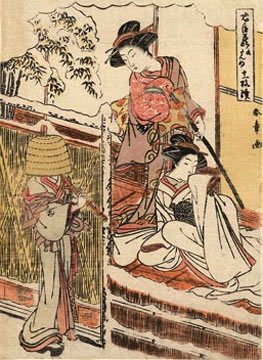
Shunsho (c. 1750s) Komuso & Ladies
MODERN
COMPOSITIONS
FOR
SHAKUHACHI
Sheet
Music
by
Contemporary Composers
in
5-Line Staff Notation
|
Shunsho (c. 1750s) Komuso & Ladies |
MODERN
COMPOSITIONS Sheet
Music |
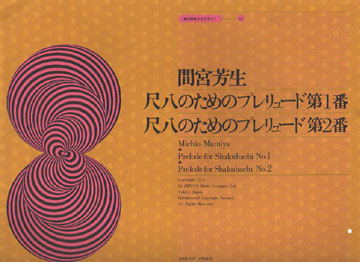 |
Michio Mamiya PRELUDE
FOR SHAKUHACHI No. 1 Prelude No. 1 is the first of Mamiya's compositions for shakuhachi. It can be played solo or duet. Prelude No. 2 was inspired by travel in the northern part of Japan where Mamiya met a player of transverse flutes. This old man played in a unique and delicate manner which was not at all traditional, but, nonetheless, very inspirational. These pieces were originally performed by brothers Chikuho Sakai and Shoda akai in 1971. Published in Japan. 14 pages. LS-1
|
Hozan Yamamoto WORKS
FOR SHAKUHACHI - VOL. 1 1. BAMBOO DUET (1962). Part
1: Deep in the moso
bamboo forest. Part 2: Young bamboo in the Japanese garden after rain.
Part 3: Hoteichiku. Comical feeling of Buddha's Belly bamboo. Published in Japan. 63 pages. HS-2
|
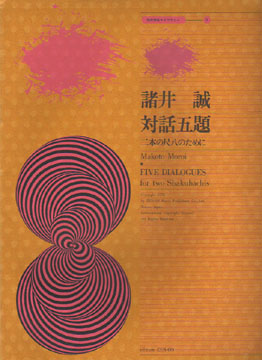 |
Makoto Moroi FIVE DIALOGUES
Written for the 1.8' and 2.4' shakuhachi, these piece explore the themes of confrontation, sin, struggle, fatality, schizophrenia and tragedy. They are a reflection of Moroi's own life which was guided by the composer's deep love for shakuhachi. This depth of feeling is expressed in a style that is both intense and primitive. The second Dialogue is inspired by the Koten honkyoku "Koku" which, for Moroi, is the ancestral voice. Published in Japan. 8 pages. BS-1
|
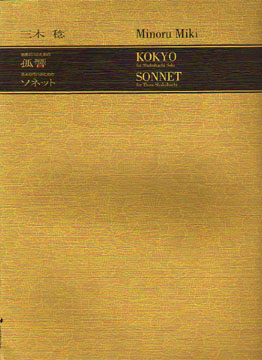 |
Minoru Miki KOKYO FOR SOLO
SHAKUHACHI "Kokyo" is the uneasy heart of a musician and his cry of prayer. This piece was first performed by Katsuya Yokoyama in 1970.It was originally written for the 2.4' shakuhachi. "Sonnet" is a lyric composition combining fragments of simple melodies. This fast-paced early work for Miinoru was composed prior to his study of honkyoku. It was originally performed by Minouru Muraoka, Katsuya Yokoyama and Kohachiro Miyata in 1962. Published in Japan. 14 pages. DS-1
|
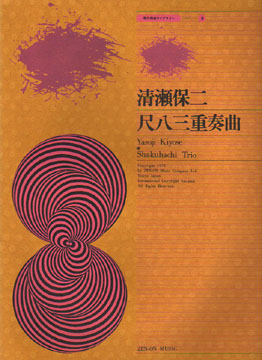 |
Yasuji Kiyose SHAKUHACHI TRIO This piece was composed for the Tokyo Sanjusodan (Tokyo Trio) featuring Katsuya Yokoyama, Kohachiro Miyata and Minoru Muraoka. Its debut performance was in 1964. Kiyose was classically trained as a Western composer and this was his first composition for traditional Japanese instruments. When asked to write a piece for three shakuhachi, he was initially hesitant to take on such a challenge. Hearing the bass shakuhachi, however, resonated deeply within Kiyose, creating a feeling of nostalgia for home. This piece uses the 5-tone pentatonic scale in conjunction with phrasing typically associated with Western music. It is comprised of three movements. The first and last are written for two 1.8' and a 2.4' shakuhachi. The second movement incorporates a shorter 1.6'. Published in Japan. 14 pages. FS-1
|
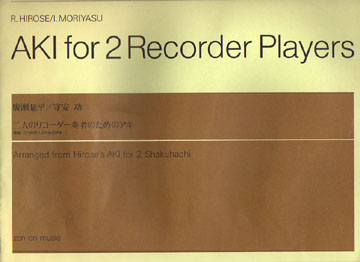 |
Ryohei Hirose / Isao Moriyasu AKI FOR 2 RECORDER PLAYERS Arranged from "AKI" means "autumn" and the composition captures the innerscape of this season in Japan. Pantheistic animism of plans and birds, mystic dialogues, meditative introspection and tender love of nature. Originally performed by Hozan Yamamoto and Katsuya Yokoyama in 1969. Published in Japan. 10 pages. GS-1
|